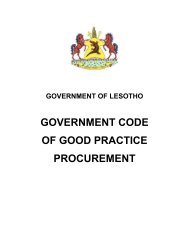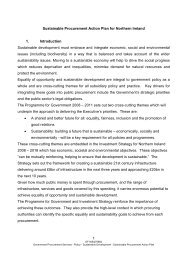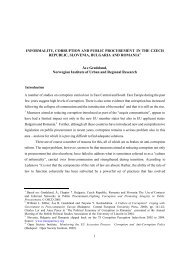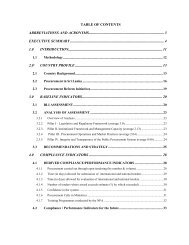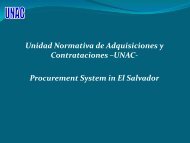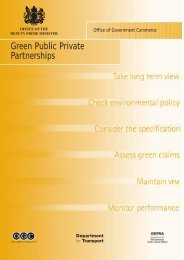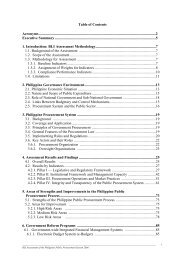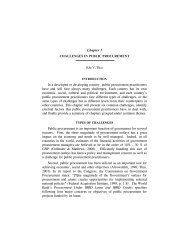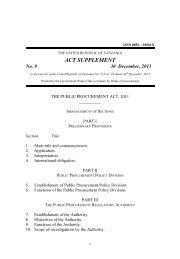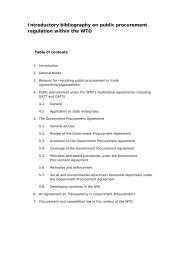Compendium of Country Examples and Lessons Learned from ...
Compendium of Country Examples and Lessons Learned from ...
Compendium of Country Examples and Lessons Learned from ...
You also want an ePaper? Increase the reach of your titles
YUMPU automatically turns print PDFs into web optimized ePapers that Google loves.
“Considerations for assessment” designed to provide additional guidance for the assessor on thecritical aspect to be examined.The findings should be recorded in a short narrative report, which discusses the probable causes fordata that do not show the expected degree <strong>of</strong> compliance.As noted in the User‟s Guide, the use <strong>of</strong> the CPIs will need to be determined on a country basis takinginto consideration the specific capacities <strong>and</strong> issues that exist in the country <strong>and</strong> the decisions <strong>of</strong> thoseparticipating in the assessment including timing, resources needed, costs involved for collecting <strong>and</strong>analysing data <strong>and</strong> conducting interviews <strong>and</strong> surveys. However, the use <strong>of</strong> the CPIs is considered tobe a critical aspect <strong>of</strong> monitoring the effectiveness <strong>of</strong> reforms that may be introduced to addressweaknesses in the overall system.<strong>Country</strong> experiencesWhen reflecting the experiences <strong>of</strong> the pilot countries on the assessment <strong>of</strong> the CPIs it was reportedthat the exercise has helped countries to identify performance issues <strong>and</strong> determine gaps in theirsystems. Keeping ownership in the implementation <strong>of</strong> the Methodology is essential for achieving theoutcome <strong>and</strong> for future commitments. This is best assured by self-assessments <strong>and</strong> joint assessments.However, it was suggested at the JV meeting in Copenhagen that further guidance, simplification <strong>of</strong>the CPIs <strong>and</strong> better alignment <strong>of</strong> the procurement assessment framework with the PEFA/PFMframework is needed. Consequently, at this very early stage <strong>of</strong> applying the compliance/performanceindicator system, the following sections will focus on presenting useful background information <strong>and</strong>on sharing experiences <strong>and</strong> challenges faced.The sampling phaseBackground informationIn order to obtain a valid picture <strong>of</strong> the performance <strong>of</strong> the procurement system, one <strong>of</strong> the mostimportant steps is to carefully consider the sample <strong>of</strong> cases <strong>and</strong> procuring entities (PEs) to be assessed.The sample needs to provide enough information in order to be able to draw conclusions, which can beregarded as valid at an aggregate level <strong>and</strong> be generalised to the procurement system as a whole.Different ways <strong>of</strong> sampling 16Should the distribution <strong>of</strong> cases be known (percentage <strong>of</strong> goods/services/works; method <strong>of</strong>procurement; contract amount; procurement at national <strong>and</strong> sub-national level, etc.) the method <strong>of</strong>“representative sampling” can be used by analysing a sufficient number <strong>of</strong> cases within eachcategory.It is also possible to draw a “r<strong>and</strong>om sample” which will need to be <strong>of</strong> sufficient size, so as to ensurethat the data collected can be seen as representative. R<strong>and</strong>om sampling is in many ways the mostadequate type <strong>of</strong> sampling, given that it is possible to draw a large enough sample <strong>and</strong> that thepopulation it is drawn <strong>from</strong> is known <strong>and</strong> defined.16To assist in carrying out the pilot assessments, the OECD Secretariat provided the OECD GuidanceNote on Data Collection <strong>and</strong> Verification.COMPENDIUM OF COUNTRY EXAMPLES AND LESSONS LEARNED […] - OECD 2008 31



